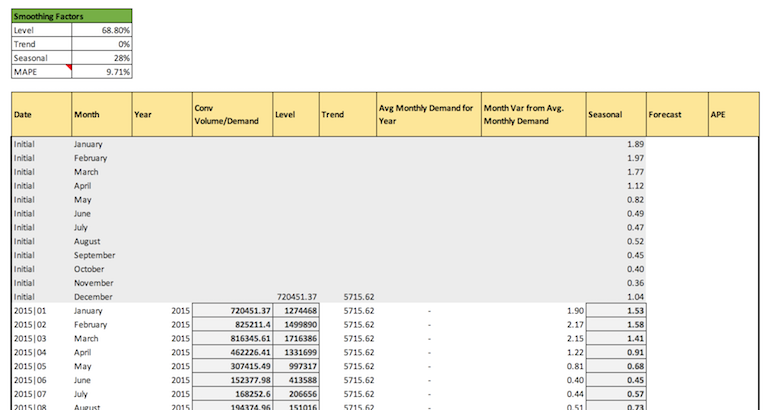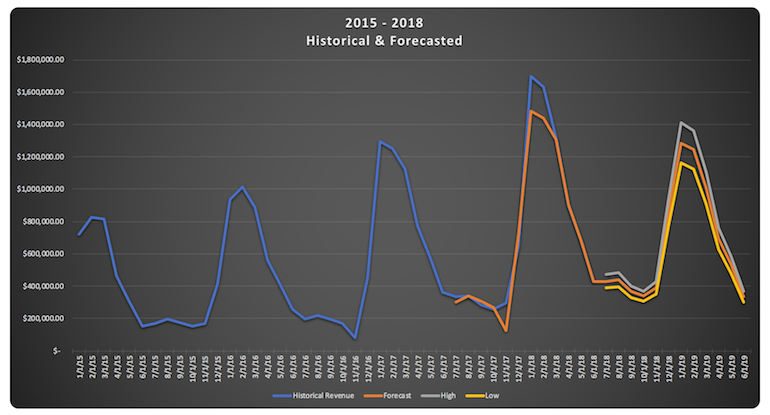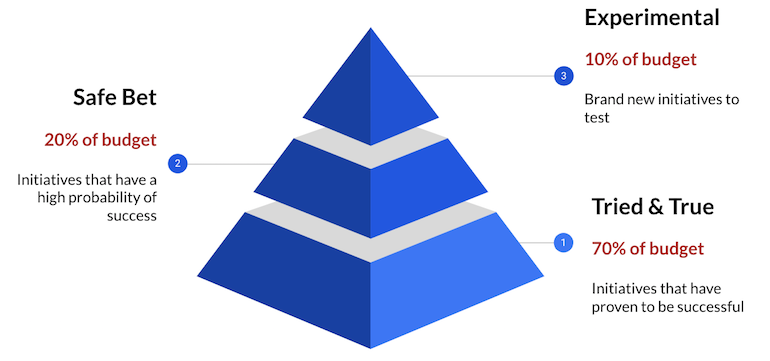“How much money should we spend on PPC this year?”
“How many sales can we get with X amount of budget?”
“We are looking at expanding into ____ platform, how much budget should we allocate?”
In the five years I’ve worked at Hanapin, these types of questions from clients are becoming more and more common. Budget recommendations and planning are not so straightforward as they once were, as the PPC landscape is ever changing and advertisers want the most bang for their buck. As an Analyst, many times these questions fall to us.
In this post I’ll walk through a framework for how we think about budgeting.
Historical Performance – Analysis & Projections
A good starting point is to take a look at what is currently running, and take a look at performance over the past twelve months.
First, look at how well (or how badly!) it performed over the course of a year. This is important if the business is impacted by any sort of seasonality. Take note of how impression share fluctuates throughout the year, and which campaigns may have been paused at certain times.
Once you have pulled historical performance, now we can begin to project future performance. There are many ways to do this, but to keep things brief here I’ll cover a couple of the more common methods we use at Hanapin.
Holt-Winters
“Holt-Winters, or exponential smoothing, is an accessible method for adjusting projections for seasonality.” – Secret Jake, Associate Director of Analytics / forecasting guru.
Here’s how the forecast works (in a nutshell):
- Monthly revenue is laid out, and average variance per month is calculated for seasonality smoothing
- A forecast is calculated using level, trend, and seasonal smoothing factors
- Excel Solver is used to set the smoothing factors to minimize MAPE (mean absolute percentage error)
- To plot the high and low estimates, we multiply this MAPE with the forecast


Organic Growth Tools
While Holt-Winters is an excellent way to forecast trends for your entire account (or selected groups of campaigns), sometimes we need to get more granular in our approach. For example, if we need to keep CPL or ROAS in mind, we would only want to max out spend for top performing campaigns.
We built a tool that takes last 30 days performance, and estimates cost and conversions based on impression share metrics, CTR, CPCs, etc. After we calculate that, we can fine tune recommendations by using filters to select only the best campaigns (and select poor performing campaigns to decrease spend).

More details on this tool can be found here.
Think about Overall Account Goals
We touched on this a little bit in the previous section, but it is crucial to keep overall account goals and strategy top of mind when discussing budget recommendations. If my goal was to make my account as efficient as possible, you wouldn’t recommend spending an extra $10k in display, would you? Of course not.
Here are a few general guidelines for budgeting based on account goals.
Goal: Account Growth
- Choose your KPI to optimize (usually conversions or revenue)
- Max out current campaigns (project performance)
- Launch new initiatives (new campaigns, platforms, networks, etc.)
- To budget for these – see the 70/20/10 rule below
Goal: Efficiency
- Select campaigns that are efficient, but have room to grow (think lost impression share due to rank or budget)
- Forecast performance for those campaigns
- Select inefficient campaigns, and project X% decrease in spend
- After you’ve worked through previous steps, then consider launching new initiatives
Goal: Branding / Awareness
The main distinction for branding and awareness budgeting, is the types of initiatives you will allocate your dollars to.
Choose campaigns or platforms that will push for impressions and interaction with your brand. Facebook, YouTube, Display, etc. are great for this type of strategy.
Reach out to Platform Reps
If you have a dedicated platform rep, they can be an excellent resource!
One of the most common questions we get from clients (besides from budgeting) is “what are my competitors doing?”. Of course, it’s going to depend on what industry you’re in, but Google, Bing, Facebook, etc. reps may be able to provide detailed industry reports. In these you’ll find trends for metrics such as queries, clicks, CPCs, and more. Integrate this into your yearly budgeting process by examining overall trends. For example, if you find that CPCs are consistently rising, factor this in to how much budget you’ll need to gain enough conversion volume.
70/20/10 Rule
We’ve discussed how to project spend and performance for what you already have running, so what do you do when you need an estimate for a completely new platform? Since we don’t have any historical data, we need some sort of guideline for budget allocation.
Our general recommendation for budget allocation is as follows:

While your budget allocation doesn’t have to line up exactly to those percentages, this serves as a general guideline. Most of your budget should be on things that have been proven successful. A good chunk of your remaining budget should be on things that you have assessed as a safe bet, with the remaining small amount set aside for experimental initiatives.
When launching something brand new, Facebook – for example, it’s important to find the sweet spot between the following:

Wrapping it Up
The bottom line of this article is this – no matter your preferred method of recommending budgets and forecasting, make sure that it aligns with the account strategy and goals. This should be your drumbeat, what you make all of your decisions off of. While we can never be 100% certain how much we’ll spend in a certain campaign, or how many conversions we’ll get, we can make some estimations. Now go forth and budget!



